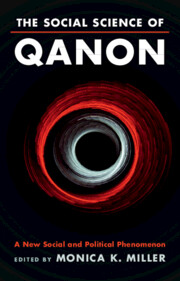Book contents
- The Social Science of QAnon
- The Social Science of QAnon
- Copyright page
- Dedication
- Contents
- Contributors
- Preface
- Part I Introduction to QAnon
- Part II Recruiting and Maintaining Followers
- Part III QAnon and Society
- Part IV The Role of Communication in Promoting and Limiting QAnon Support
- Part V The Future of QAnon
- Chapter 16 Categorizing QAnon
- Chapter 17 The Future of QAnon
- Index
- References
Chapter 17 - The Future of QAnon
Emergent Patterns of Social Movement Adaptation and Change
from Part V - The Future of QAnon
Published online by Cambridge University Press: 14 September 2023
- The Social Science of QAnon
- The Social Science of QAnon
- Copyright page
- Dedication
- Contents
- Contributors
- Preface
- Part I Introduction to QAnon
- Part II Recruiting and Maintaining Followers
- Part III QAnon and Society
- Part IV The Role of Communication in Promoting and Limiting QAnon Support
- Part V The Future of QAnon
- Chapter 16 Categorizing QAnon
- Chapter 17 The Future of QAnon
- Index
- References
Summary
Drawing on the themes of the previous chapters, this chapter considers the future of QAnon. It examines evidence of new and ongoing developments in the QAnon movement following the electoral loss of President Trump. QAnon has shown a particular ability to re-invent itself in the face of failed predictions, “frame bridging” or brokering ties with existing social networks and movements including lifestyle and wellness communities, anti-vaxxers, deep state conspiracists, radical religious right factions, Patriot and militia movement actors, and other conspiracy-minded groups. As such, QAnon has evolved and become a movement with a life of its own, independent of Trump. While Trump embraced conspiracy theories promulgated by QAnon such as the existence of a “deep state” intent on sabotaging the president’s policies, the range of conspiratorial ideas expand well beyond his administration. Herein, we explore indications of post-Trump era trajectories of QAnon from a social movement perspective, examining preliminary evidence of movement adaptation and change to shifting political conditions. These conditions include the political pressure exerted on major social media platforms such as Facebook and Twitter to tamp down on misinformation freely circulated by QAnon followers, the election of Joe Biden and the transition to a new administration in the White House, the emergence of a QAnon religion, and the spreading influence of QAnon abroad, adapted and revised for different political environments.
Keywords
- Type
- Chapter
- Information
- The Social Science of QAnonA New Social and Political Phenomenon, pp. 291 - 307Publisher: Cambridge University PressPrint publication year: 2023

